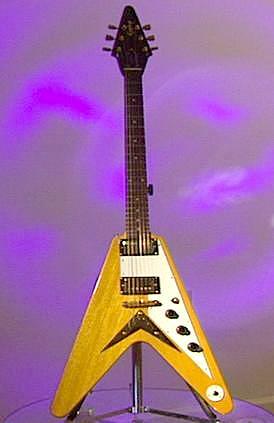Replacing Pickups in an Epiphone '58 Flying V
About ten years ago in a "dad and lad thing" I bought my son and I matching Epiphone electric guitars for Christmas. He got the korina Explorer and I got a matching korina '58 Flying V. Since then, the Flying V has served me as a slide guitar and has been featured in a TV story that has been broadcast around the world. It has also gone back and forth between my son and myself. Eventually my son confessed that he liked the V more than his Explorer so I picked up an inexpensive faded Gibson V and told him to hold on to the Epi.
Both of the Epis have the classic Epiphone problems with microphonic pickups. At gain levels above a clean sound the guitars live right on the edge of screechy high-end feedback. When I worked with the Flying V live I had to back off the high-end for it to be useful at all. Recently my son decided to replace the pickups and asked me to help him. He ordered a pair of Seymour Duncans, a JB SH-4 for the bridge and a SH-1 59 Model for the neck. He also ordered a Switchcraft blade switch to replace the Epi switch that had become intermittent. Last night we spread a towel on the dining room table, laid out the tools, fired up the soldering iron, and dived in.
Before starting we measured the height from the deck of the bridge and pickups so we could reproduce his settings. That turned out to be something of a waste because before it was over, my son ended up wanting an action set up as well. After pulling the pickguard the first thing we discovered was that the high quality Switchcraft switch was deep enough that it simply wasn't going to fit. So much for that. Next we unscrewed the pickup rings and traced and diagrammed the wiring before unsoldering the pickups. Then it was time to put the new pickups in the guitar's pickup rings. The new pickups fit the rings perfectly. The biggest headache was re-compressing the pickup springs while getting the first few winds of the pickup screws threaded down. Part of the problem was that the old pickup screws needed to be replaced by the new ones supplied with the pickups - the old ones turned out to be slightly larger and thus wouldn't fit the ears of the pickup. We found that out the hard way. But frankly, even Seymour in the videos on the Seymour Duncan site struggled with the springs. It took him multiple tries, shooting the springs across the room, and he admitted that he edited out the unsuccessful tries to make the video short and to the point. There doesn't seem to be a secret that once learned makes it simple. Instead it's more like, try, try, sprioooing!, try, oops!, try, yeah!!! *Phwew!* That's done. Twice.
Once we got the pickups in the rings, the wires fished through, and the rings screwed down, it was a fairly simple matter to follow the wiring diagrams in the instructions and solder the pickups back into the circuit. My son chose not to split the splittable 59 Model for the neck so we made note of that. We buttoned everything back up, leaving the pickguard in place but loose in case something didn't work. Then we strung up the guitar and roughed in the action because the pickup heights would have to conform to that. Then it was time to plug in and listen.
Et Voile'! and WOW!!! what a difference in the guitar! The pickups took the guitar from borderline to great! The result was a solid, smooth-sounding guitar with deep bass, a full but smooth midrange, and pretty highs. Then we set the pickup heights to balance the output of the pickups and they balanced out nicely. There were a couple of action and pickup adjustments as we went along. I was simply amazed. Finally, it was time for the weekly jam between my son and I. He played his Flying V against my Les Paul and the V was clearly in the same tonal league, but with a sound of its own. We tested it through a Big Muff PI and a Proco Rat for gain and didn't have as much as a hint of feedback. The noise rejection was excellent as well. We spent the rest of the night shaking our heads and saying, "Wow, I can't get over the sound of this guitar!" We were also pleasantly surprised with the aesthetic result: My son had purchased uncovered double-black humbuckers and we came to the conclusion over the evening that his guitar looked better with them than it had with the original gold covers.
So, folks, it is possible to make a HUGE difference with an Epi electric guitar with a simple replacement of pickups. You'll need soldering and organization skills. If you feel you can't pull it off yourself, consider getting you dealer to do it for you. You'll easily be rewarded for your effort and expense with a great sounding guitar. I'm considering the same pickup upgrade for my Gibson faded V. Its 490s are a bit gainy for my tastes.
SEYMOUR DUNCAN
= =
=


